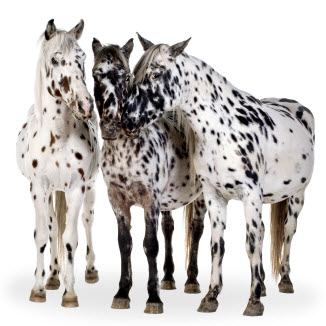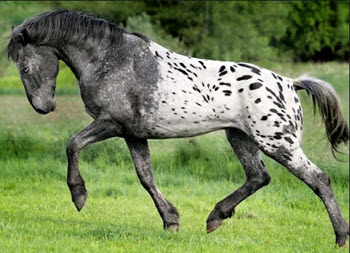Appaloosa horse characteristics
The Leopard-complex gene
 The Appaloosa horse breed is famous for the distinctive patterned coat, even though not all registered Appaloosas look like this. Examples of other core characteristics are striped hooves, mottled skin, and eyes where you can see white sclera even when the eye is held in its normal position. Mottled skin is typically seen around the eyes, muzzle, genitalia and anus.
The Appaloosa horse breed is famous for the distinctive patterned coat, even though not all registered Appaloosas look like this. Examples of other core characteristics are striped hooves, mottled skin, and eyes where you can see white sclera even when the eye is held in its normal position. Mottled skin is typically seen around the eyes, muzzle, genitalia and anus.
The Appaloosa’s fascinating spotting patterns are collectively known as the leopard-complex. Any horse that displays Appaloosa core characteristics – such as the distinctive coat patterns, the mottled skin, the striped hooves, and the visible white sclera – is a carrier of at least one allele of the dominant leopard-complex (LP) gene.
Conversely, all horses that carry at least one allele of this gene will display leopard characteristics. This does not mean that they must have visible coat spotting. There are many examples of apparently solid-colored horses that, upon closer inspection, are revealed to have a visible white sclera, vertically striped hooves, and mottled skin around the eyes, lips and genitalia – all tell-tale signs of the LP gene.
A horse that is heterozygous for LP is normally darker than a horse that is just homozygous for LP, although there are many exceptions.
It should also be noted that some Appaloosas display sabino or pinto type markings, because pinto genes can cover-up or obscure Appaloosa patterns. (Horses with excessive white pinto-style markings can not be registered with the ApHC, not even if both parents are registered Appaloosas.)
An intricate situation
LP is an autosomal incomplete dominant mutation in the TRPM1 gene, a gene located at horse chromosome 1 (ECA 1). It hypothesized, but not proven, that LP acts together with other patterning genes (PATN) in horses; genes that are yet to be identified. If this is true, it would explain why the mechanism by which the pattern is produced in each individual horse is so difficult for us to understand when we look at the LP gene only.
Coat
 The coat color of an Appaloosa is a combination of a base color and an overlaid spotting pattern.
The coat color of an Appaloosa is a combination of a base color and an overlaid spotting pattern.
The Appaloosa Horse Club in the United States (this club is the world’s largest breed registry for Appaloosas) accepts many different base colors, including black, grey, chestnut, bay, buckskin, palmino, cremello or perlino, grulla, and dun.
The spots overlay darker skin and are sometimes surrounded by a “halo”. A halo is seen when the skin next to the spot is dark like the spot, but the overlying hair coat is white.
Solid-colored?
A solid-colored horse has a base color but not contrasting color in the form of an Appaloosa coat pattern.
A solid-colored horse can be registered with the Appaloosa Horse Club if it has mottled skin and at least one more leopard-complex characteristic, such as striped hooves or visible white sclera.
A horse with no identifiable Appaloosa characteristics, but where both parents are registered with the Appaloosa Horse Club, is registered as a non-characteristic, a registration which confers it limited special registration status.
Changes
The Appaloosa Horse Club encourages early registration of foals, even though it can be difficult to predict what the individual will look like as it matures. Also, it is not unusual for Appaloosas to continue to change their pattern somewhat throughout their lives.
Just as with most other horse breeds, the Appaloosa foal is normally born with a fairly light coat that becomes darker as the foal sheds its baby hair. Sometimes, the foal will not display any classic leopard-complex characteristic while young, despite being the offspring of two carriers of the leopard-complex gene.
Many adult Appaloosas that display varnish roan and snowflake patterns did not look like that when they were born – they developed this noticeable look as they grew older.
Hooves
A common misconception is that all horses with vertically striped hooves are Appaloosas. Striped hooves are found in several horse breeds, not just in Appaloosas.
Eyes
Pretty much any horse will show some white when the eye is rolled back, but the Appaloosa have a readily visible white sclera even when the eye is kept in a normal position. This trait is not unique to the Appaloosa, but it is less common in other breeds.
What is the sclera?
The sclera is the part of the eye surrounding the iris.
Body types
With the leopard-complex being the primary identifying factor of the breed, a wide range of body types can be seen among the registered Appaloosas. This reflects how many different horse breeds influenced, and to a certain degree continue to influence, the Appaloosa breed.
The height varies from 14 to 16 hands, with the ApHC not permitting pony or draft breeding.
The smallest adult Appaloosas tend to weigh around 950 lbs, while the heaviest ones weigh in at 1,250 lbs or so.
This article was last updated on: November 20, 2017